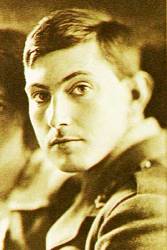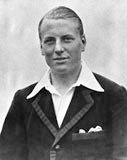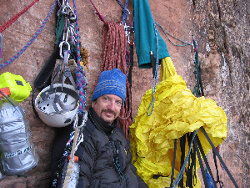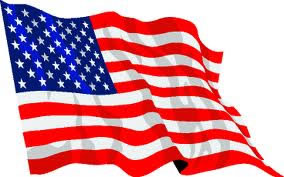
Left: George Mallory and Andrew Irvine © RGS/The Sandy Irvine Trust, from "Ghosts of Everest" ; Right: 1924 North Face locations © Pete
| Photoanalysis | Routes & Maps | Video & Books | Contact Me |


"I'm quite doubtful if I shall be fit enough. But again I wonder if the monsoon will give us a chance. I don't want to get caught, but our three-day scheme from the Chang La will give the monsoon a good chance. We shall be going up again the day after tomorrow. Six days to the top from this camp!"
--from George Mallory's last letter to his wife prior to disappearing on Mt. Everest with his partner Andrew "Sandy" Irvine in 1924
"My face is in perfect agony. Have prepared two oxygen apparatus for our start tomorrow morning".
- Sandy Irvine's last diary entry

About Me
 Celebrating my 50th birthday on pitch 3 of Prodigal
Son, Zion National Park, Utah (guided, all I did was jug up the ropes!)
Celebrating my 50th birthday on pitch 3 of Prodigal
Son, Zion National Park, Utah (guided, all I did was jug up the ropes!)
I am an Emeritus Professor of Chemistry at Western Oregon University where I taught for 31 years.

History of Mount Everest from 1903 - 1975 (copyright © 2005-2023)
Reference: "Everest" 3rd ed, by Walt Unsworth
Page 1 Page 2 Page 3 Page 4 Page 5 Page 6
1903: The Viceroy of India, Lord Curzon, concerned about possible Russian influence inside Tibet, sends Sir Francis Younghusband to ostensibly negotiate "frontiers and trade". The Tibetans refuse to enter negotiations, so Younghusband leads a British Army Expedition to Lhasa. A treaty is eventually signed in September, 1904, after the Dalai Lama flees to Mongolia.
1904: A member of Younghusband's staff, J. Claude White, photographs the Eastern side of Everest from Kampa Dzong, 94 miles away. While not the first photograph of Everest ever taken, it's the first to show any significant details of the mountain.
1907: Natha Singh, a member of the British Indian Survey, obtains permission to enter the Mount Everest region from the Nepalese side. He maps the Dudh Kosi valley - gateway to the southern route up the mountain - all the way to the end of the Khumbu Glacier.
1913: Captain John Noel, a British military officer, travels to Tibet in disguise (at the time foreigners were forbidden in Tibet) to find the best way to approach Everest. He comes to within 60 miles of Everest, only to find his way blocked by an unexpected mountain range that did not appear on his faulty maps. Noel is able to view the top 1000 feet (300 meters) of Everest when it appears out of the shifting mists, a "glittering spire of rock fluted with snow".
1920: The Dalai Lama opens Tibet to outsiders after the political situation involving China and Russia relaxes somewhat. The Royal Geographic Society and the Alpine Club hold a joint meeting to discuss how to proceed with an expedition to Mount Everest. Explorers had reached both the North and South Poles, so the next "feat" was Everest. The Mount Everest Committee is established by Younghusband, and a formal resolution is passed stating that an expedition would take place the following year with reconnaissance as the first priority, (although a summit attempt was not discouraged). A full-scale summit attempt was to be launched the following year in 1922.
1921: The First British Everest Reconnaissance Expedition to the mountain, led by Lt. Colonel Charles Howard-Bury. This is George Leigh Mallory's first trip to the mountain. After spending ten weeks exploring the northern and eastern reaches of the mountain, on September 24, 1921, Guy Bullock and George Mallory were the first climbers to reach the North Col of Everest at an altitude of around 23,000 feet (7000 meters). The northern route up the mountain had now been established.
1922: The Second British Everest Expedition to the mountain, led by Brigadier General C.G. Bruce, following the same route reconnoitered the previous year. George Mallory returns along with climbers George Finch, Geoffrey Bruce, Henry Morshead, Edward Norton, Howard Somervell, and John Noel as expedition filmmaker. On May 22nd, Mallory, Norton, Somervell and Morshead make the first assault, and climb to 26,800 feet (8170 m) on the North Ridge before retreating. On May 23rd, George Finch and Geoffrey Bruce climb up the North Ridge and Face to 27,300 (8320 meters) feet using oxygen. On June 7th, Mallory leads a third attempt on the summit that claims the lives of seven Sherpa climbers in an avalanche below the North Col, the first reported deaths on Everest.
1923: While on a lecture tour in the United States, a reporter asks Mallory why he wants to climb Everest, and Mallory immortally replies "Because it's there".
Page 1 Page 2 Page 3 Page 4 Page 5 Page 6

News
2019 Searches and Evidence that Irvine and the Camera Were Found by the Chinese in 1975?
 Along with Mark Synnott, Thom Pollard was part of the National Geographic 2019 search, as well as a member of the 1999 search that found Mallory's body. I recommend his Facebook page as well as his YouTube channel where he has been producing videos dealing with the new theories that are given below.
Along with Mark Synnott, Thom Pollard was part of the National Geographic 2019 search, as well as a member of the 1999 search that found Mallory's body. I recommend his Facebook page as well as his YouTube channel where he has been producing videos dealing with the new theories that are given below.
After his book "The Third Pole: Mystery, Obsession, and Death on Mount Everest" was published, Synnott uncovered resarch that seems to prove that Irvine and the camera were found by the Chinese back in 1975.
Let's not forget that Jake Norton was on a Discovery Channel search at the same time, but looking in a different place!
There were two films produced about these searches, and you can watch them here: Pollard/Synnott movie "Lost on Everest (Discovery+), and the Norton film Everest's Greatest Mystery (this is an Amazon Prime link, but the movie is available on AppleTV as well).
New Theories
 It has recently come to my attention the theories of Ajay Dandekar, a historian and a faculty member of Shiv Nadar University, Delhi. I find his theory that Irvine stayed behind in a sleeping bag while Mallory went to the summit to be highly questionable. Please see my two part series on why I think this is true: Part 1 and Part 2
It has recently come to my attention the theories of Ajay Dandekar, a historian and a faculty member of Shiv Nadar University, Delhi. I find his theory that Irvine stayed behind in a sleeping bag while Mallory went to the summit to be highly questionable. Please see my two part series on why I think this is true: Part 1 and Part 2
 He's been around for awhile, but you'll want to read Michael Tracy's thoughts of what happened to Mallory and Irvine, along with his repository of YouTube videos. He's very mercurial and you'll need a thick hide if you debate him!
He's been around for awhile, but you'll want to read Michael Tracy's thoughts of what happened to Mallory and Irvine, along with his repository of YouTube videos. He's very mercurial and you'll need a thick hide if you debate him!
New Mallory and Irvine Forum hosted by Jake Norton
 Please visit and become a member of Jake Norton's new Mallory and Irvine forum. You'll want to check out his image-based collection of all of the searches for Irvine from 1999 to 2019. He also has a three part series on his theory of what happened to Mallory and Irvine: part 1, part 2, part 3. And finally, here is the link to his Mallory and Irvine archive.
Please visit and become a member of Jake Norton's new Mallory and Irvine forum. You'll want to check out his image-based collection of all of the searches for Irvine from 1999 to 2019. He also has a three part series on his theory of what happened to Mallory and Irvine: part 1, part 2, part 3. And finally, here is the link to his Mallory and Irvine archive.

Articles and Editorials
A new article by researcher Wim Kohsiek, who has convincingly interpreted the time Mallory's watch was pointing to when it stopped, at odds with Jochen Hemmleb's interpretation that it was pointing to the time of Odell's sighting of the pair at 12:50 pm.
An interview with Graham Hoyland, author of the new book “Last Hours on Everest - The gripping story of Mallory and Irvine's fatal ascent”
Harvey V. Lankford, MD, has written a paper documenting the origin of the term "Glacier Lassitude" as a diagnosis for the debilitating effect of altitude as experienced by members of the early British Everest expeditions.
My new "what if?" theory about Mallory and Irvine's last climb, where I assume Odell's sighting was erroneous, and have them taking the Couloir route instead.
Part 1: the ascent
Part 2: the descent
Warwick Pryce is a new researcher who has arrived on the scene, and he has a new theory about how Andrew Irvine could have been the first person to stand on the top of the world.
Wim Kohsiek has a new interpretation of what Mallory's altimeter can tell us based on scientific applications of meterology.
Mallory and Irvine researcher Wim Kohsiek has two new thought-provoking articles about Mallory's watch and Irvine's location:
Mallory's Watch - Does it Really Point to 12:50 PM?
1924 Oxygen by Richard McQuet and Pete Poston
Why the Camera and Film are not Doomed to Destruction!
The Politics of Mallory and Irvine
Why Andrew Irvine Will Not be Found in a Sleeping Bag! Part 1 and Part 2
Chomolungma Nirvana: The Routes of Mount Everest
Rust Marks on Mallory's Altimeter
Little Known Free-Solo Ascent of the Second Step in 2001 by Theo Fritsche - I should never have written this - Anker and Houlding deserve credit for the first free ascent
Criticisms of the 2004 EverestNews.com search for Irvine --
The Mystery of Mallory and Irvine's Fate (with J. Hemmleb): Part 1, Part 2, Part 3, Part 4, Part 5.
Mallory and Irvine - Comments on the 'real Second Step' route: Part 1 and Part 2
Conrad Anker's comments on the unlikeliness of a direct route up the prow of the 2nd Step
Articles about my heroes Walter Bonatti and Chris Bonington --
Spilling the Beans - Lino Lacedelli's Book "Price of Conquest: Confessions from the First Ascent of K2" Part 1 and Part 2
The Life and Climbs of Chris Bonington, Part 1, Part 2, Part 3, Part 4, Part 5 final - interview
|
Copyright (c) 2004-2022 Pete Poston. All rights reserved. Visitor's Agreement |